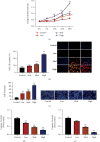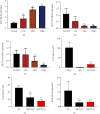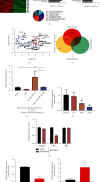Human Umbilical Cord Mesenchymal Stem Cells Improve Premature Ovarian Failure through Cell Apoptosis of miR-100-5p/NOX4/NLRP3
- PMID: 35845923
- PMCID: PMC9283025
- DOI: 10.1155/2022/3862122
Human Umbilical Cord Mesenchymal Stem Cells Improve Premature Ovarian Failure through Cell Apoptosis of miR-100-5p/NOX4/NLRP3
Retraction in
-
Retracted: Human Umbilical Cord Mesenchymal Stem Cells Improve Premature Ovarian Failure through Cell Apoptosis of miR-100-5p/NOX4/NLRP3.Biomed Res Int. 2023 Jun 21;2023:9848903. doi: 10.1155/2023/9848903. eCollection 2023. Biomed Res Int. 2023. PMID: 37388357 Free PMC article.
Abstract
Premature ovarian failure refers to a series of symptoms of perimenopausal hot flashes, night sweats, decreased libido, vaginal dryness, insomnia, reduced menstruation, sparse hair, even amenorrhea, and even infertility before the age of 40 due to the decline of ovarian function. Premature ovarian failure is a common and difficult disease in gynecology. Its prevalence is increasing gradually, and the trend is younger. The aim of this experiment was to elucidate the role of human umbilical cord mesenchymal stem cells (HUCMSCs) in premature ovarian failure and its mechanism. HUCMSCs, KGN cells, and HEK293T cells were used in this experiment. Quantitative PCR and microarray analysis, ELISA inflammation and oxidative stress kits, RNA pull-down assay, luciferase reporter assay, proliferation assay, EDU staining, and Western blot analysis were used. In an in vitro model of premature ovarian failure, HUCMSCs attenuated inflammatory response, oxidative stress, and apoptosis. HUCMSCs ameliorated the premature ovarian failure model. The miR-100-5p expression was induced by HUCMSCs through methylation. miR-100-5p regulation influenced the role of HUCMSCs in an in vitro model of premature ovarian failure. HUCMSCs inhibited the in vitro expression of NOX4, NLRP3, and GSDMD proteins in the model. NOX4/NLRP3 signaling pathway affects the role of HUCMSCs in an in vitro model of premature ovarian failure through miR-100-5p. This experiment elucidated the role of HUCMSCs in premature ovarian failure and its mechanism, with a view to providing a clinical reference.
Copyright © 2022 Jing Niu et al.
Conflict of interest statement
The authors declare that there are no conflicts of interest regarding the publication of this paper.
Figures







Similar articles
-
miR-126-3p containing exosomes derived from human umbilical cord mesenchymal stem cells promote angiogenesis and attenuate ovarian granulosa cell apoptosis in a preclinical rat model of premature ovarian failure.Stem Cell Res Ther. 2022 Jul 26;13(1):352. doi: 10.1186/s13287-022-03056-y. Stem Cell Res Ther. 2022. PMID: 35883161 Free PMC article.
-
Exosomes from human umbilical cord mesenchymal stem cells inhibit ROS production and cell apoptosis in human articular chondrocytes via the miR-100-5p/NOX4 axis.Cell Biol Int. 2021 Oct;45(10):2096-2106. doi: 10.1002/cbin.11657. Epub 2021 Jul 29. Cell Biol Int. 2021. PMID: 34197004
-
Improving Granulosa Cell Function in Premature Ovarian Failure with Umbilical Cord Mesenchymal Stromal Cell Exosome-Derived hsa_circ_0002021.Tissue Eng Regen Med. 2024 Aug;21(6):897-914. doi: 10.1007/s13770-024-00652-2. Epub 2024 Jun 6. Tissue Eng Regen Med. 2024. PMID: 38842768 Free PMC article.
-
HucMSCs-exosomes containing miR-21 promoted estrogen production in ovarian granulosa cells via LATS1-mediated phosphorylation of LOXL2 and YAP.Gen Comp Endocrinol. 2022 Jun 1;321-322:114015. doi: 10.1016/j.ygcen.2022.114015. Epub 2022 Mar 7. Gen Comp Endocrinol. 2022. PMID: 35271888
-
Transplantation of human umbilical cord mesenchymal stem cells to treat premature ovarian failure.Stem Cell Res Ther. 2021 Aug 11;12(1):454. doi: 10.1186/s13287-021-02529-w. Stem Cell Res Ther. 2021. PMID: 34380572 Free PMC article. Review.
Cited by
-
A Review on Treatment of Premature Ovarian Insufficiency: Characteristics, Limitations, and Challenges of Stem Cell versus ExosomeTherapy.Vet Med Int. 2023 Nov 17;2023:5760011. doi: 10.1155/2023/5760011. eCollection 2023. Vet Med Int. 2023. PMID: 38023426 Free PMC article. Review.
-
Retracted: Human Umbilical Cord Mesenchymal Stem Cells Improve Premature Ovarian Failure through Cell Apoptosis of miR-100-5p/NOX4/NLRP3.Biomed Res Int. 2023 Jun 21;2023:9848903. doi: 10.1155/2023/9848903. eCollection 2023. Biomed Res Int. 2023. PMID: 37388357 Free PMC article.
-
miRNA-Guided Regulation of Mesenchymal Stem Cells Derived from the Umbilical Cord: Paving the Way for Stem-Cell Based Regeneration and Therapy.Int J Mol Sci. 2023 May 24;24(11):9189. doi: 10.3390/ijms24119189. Int J Mol Sci. 2023. PMID: 37298143 Free PMC article. Review.
-
The dual role of mesenchymal stem cells in apoptosis regulation.Cell Death Dis. 2024 Apr 6;15(4):250. doi: 10.1038/s41419-024-06620-x. Cell Death Dis. 2024. PMID: 38582754 Free PMC article. Review.
-
[Exploring the therapeutic mechanism of Liuwei Suanzao decoction for perimenopausal insomnia based on network pharmacology and animal experiments].Nan Fang Yi Ke Da Xue Xue Bao. 2023 Sep 20;43(9):1536-1547. doi: 10.12122/j.issn.1673-4254.2023.09.11. Nan Fang Yi Ke Da Xue Xue Bao. 2023. PMID: 37814868 Free PMC article. Chinese.
References
Publication types
MeSH terms
Substances
LinkOut - more resources
Full Text Sources
Medical

